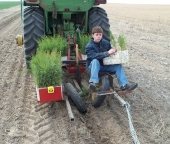posted 14 years ago
I'm working on a similar sort of thing on 2.5 acres and using many of the techniques mentioned.
I sowed 50# buckwheat across ~1/2 acre in mid summer. I cut the grass to 2" right after seeding. The seed germinated well but most of it didn't get really large, the lowest, wettest spots did very well. Buckwheat seems to be a negative allelopath towards grasses, as other areas cut at the same time but not seeded are much taller. Many other beneficials are doing fine with the buckwheat (yarrow, yellow dock, wild strawberry, wild carrot, dandelion, etc.). So the overall goal of reducing grass while maintaining diversity was somewhat successful. All the buckwheat has gone to seed, and this week I'll be seeding white ladino and red clover and cutting to 3". Soon after seeding the buckwheat I also planted 60 Comfrey root cuttings, all of which are now 2-4" above ground and growing fast. In the spring I'll be spreading lots of seed, mostly from wildharvested edibles/medicinals on the property or in nearby forests (sochan, bee balm, anise-hyssop, burdock, wild carrot, etc.)
Amongst this large scale grass war, I'm going to start cardboard mulching small sections (10'x10') to plant fruits, nuts, and companions this autumn and annuals next spring. I've read about the moving landscape fabric working very well, but cardboard is free. My annuals are mostly going to be gourds, pumpkins, watermelons, sweet potatoes to continue shading out the grass while providing some yields. I would highly recommend sweet potato, I made my own slips last spring and succesfully killed a lot of grass in a suburban lot with ~50 plants made from $3 of sweet potatoes. They grow in poor hard soil, the leaves are edible, the tubers are super nutritious, and even if you don't dig them all up they break up soil and add tons of OM. I'll also be planting large areas of sunchoke + groundnut + various groundcovers.
Additionally, I'm dragging fallen logs out of nearby woods to accentuate the contours in the meadow, and aim to achieve a sort of lazy huggelkultur by piling biomass over the log piles on contour. There's also a system of narrow trench ponds going in across the full 2.5 acres. Well, better get back to work!
peace






